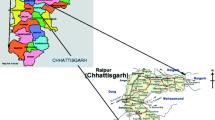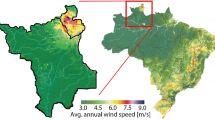Abstract
Generalized Pareto distributions (GPD) are frequently applied for the statistical analysis of extreme wind speeds. A central topic in extreme-value theory is the adaptive estimation of the extreme-value index γ. Several authors have demonstrated a high sensitivity of γ against the threshold when analyzing extreme wind speeds. This undesirable effect introduces the difficulty to provide reliable quantile estimates. This paper aims to bring this problem to meteorologists and proposes a stable estimator (the Zipf estimator) for γ. This could allow a more objective prior identification of the sign and range of γ. The method is based on regression in the so-called generalized quantile plots. A comparative study with a classical estimator (the probability-weighted method) is made and it is shown that the Zipf estimator significantly decreases the variance in the calibration of the GPD to extreme wind gusts. Finally, the new methodology is applied to get improved prediction of extreme wind gusts in Belgium.








Similar content being viewed by others
References
An Y, Pandey MD (2005) A comparison of methods for extreme wind speed estimation. J Wind Eng Ind Aerodyn 93:535–545
Balkema A, de Haan L (1974) Residual life time at great age. Ann Probab 5:792–804
Beirlant J, Vynckier P, Teugels JL (1996) Excess functions and estimation of the extreme value index. Bernoulli 2:293–318
Beirlant J, Goegebeur Y, Segers J, Teugels J (2004) Statistics of extremes. Wiley Ltd, Sussex, p 484
Beirlant J, Dierckx G, Guillou A (2005) Estimation of the extreme-value index and generalized quantile plots. Bernoulli 11:949–970
Brabson BB, Palutikof JP (2000) Test of the generalized Pareto distribution for predicting extreme wind speeds. J Appl Meteorol 39:1627–1640
Coles S (2001) An Introduction to statistical modelling of extreme values. Springer, New York
Coles SG, Walshaw D (1994) Directional modelling of extreme wind speeds. Appl Stat 43:139–157
Cook NJ (1985) The designer’s guide to wind loading of building structures. Butterworths, London, Boston
Csörgő S, Viharos L (1998) Estimating the tail-index. In: Szyszkowicz B (ed) Asymptotic methods in probability and statistics. North-Holland, Amsterdam, pp 833–883
Cunnane C (1978) Unbiased plotting positions—a review. J Hydrol 37:205–222
Demarée GR, Muir-Wood R (2009) De “Grote Storm van december 1703” in de Lage Landen—een stormachtige periode in de Spaanse Successieoorlog. In: de Kraker AMJ, van der Windt HJ (eds) Jaarboek voor Ecologische Geschiedenis 2008. Klimaat en atmosfeer in beweging. Academia Press, Gent and Uitgeverij Verloren, Hilversum, pp 33–54
Efron B, Tibshirani RJ (1993) An introduction to the bootstrap. Chapman & Hall, New York, London, p 456
Embrechts P, Klüppelberg C, Mikosch T (1997) Modelling extremal events for insurance and finance. Springer-Verlag, Berlin, Heidelberg, p 648
Galambos J, Nicholas M (1999) Classical extreme value model and prediction of extreme winds. J Struct Eng 125:792–794
Gusella V (1991) Estimation of extreme winds from short-term records. J Struct Eng 117:375–390
Harris I (2005) Generalized Pareto methods for wind extremess. Useful tool or mathemat- ical mirage? J Wind Eng Ind Aerodyn 93:341–360
Holmes JD, Moriarty WW (1999) Application of the generalized Pareto distribution to extreme value analysis in wind engineering. J Wind Eng Ind Aerodyn 83:1–10
Hosking JRM, Wallis JR (1987) Parameter and quantile estimation for the generalized Pareto distribution. Technometrics 29:339–349
Lechner JA, Simiu E, Heckert NA (1993) Assessment of ‘peak over threshold’ methods for estimating extreme value distribution tails. Struct Saf 12:305–314
Payer T, Küchenhoff H (2004) Modelling extreme wind speeds at a German weather station as basic input for a subsequent risk analysis for high-speed trains. J Wind Eng Ind Aerodyn 92:241–261
Pettitt AN (1979) A non-parameteric approach to the change-point problem. Appl Stat 28:126–135
Perrin O, Rootzén H, Taessler R (2006) A discussion of statistical methods for estimation of extreme wind speeds. Theor Appl Climatol 85:203–215
Pickands J (1975) Statistical interference using extreme order statistics. Ann Stat 3:119–131
Risk Management Solutions (2003) December 1703 windstorm, 300-Year retrospective. Risk Management Solutions Reports
Sacré C, Moisselin JM, Sabre M, Flori JP, Dubuisson B (2007) A new statistical approach to extreme wind speeds in France. J Wind Eng Ind Aerodyn 95:1415–1423
Simiu E, Heckert NA (1996) Extreme wind distribution tails: a ‘peaks over threshold’ approach. J Struct Eng 122:539–547
Simiu E, Heckert NA, Filliben JJ, Johnson SK (2001) Extreme wind load estimates based on the gumbel distribution of dynamic pressure: an assessment. Struct Saf 23:221–229
Stedinger JR, Vogel RM, Foufoula-Georgiou E (1993) Frequency analysis of extreme events. In: Maidment DR (ed) Handbook of hydrology. McGraw-Hill, USA, pp 18.1–18.66
van den Brink HW, Können GP, Opsteegh JD (2004) Statistics of extreme synoptic-scale wind speeds in ensemble simulations of current and future climate. J Clim 17:4564–4574
Author information
Authors and Affiliations
Corresponding author
Rights and permissions
About this article
Cite this article
Van de Vyver, H., Delcloo, A.W. Stable estimations for extreme wind speeds. An application to Belgium. Theor Appl Climatol 105, 417–429 (2011). https://doi.org/10.1007/s00704-010-0365-9
Received:
Accepted:
Published:
Issue Date:
DOI: https://doi.org/10.1007/s00704-010-0365-9




